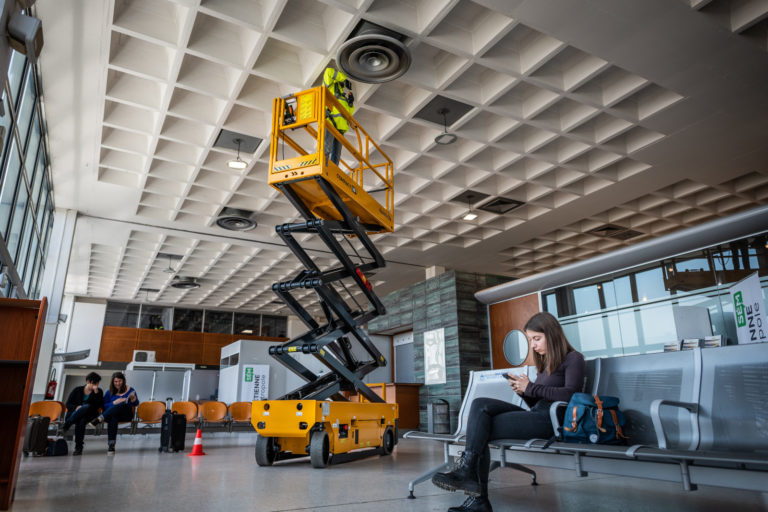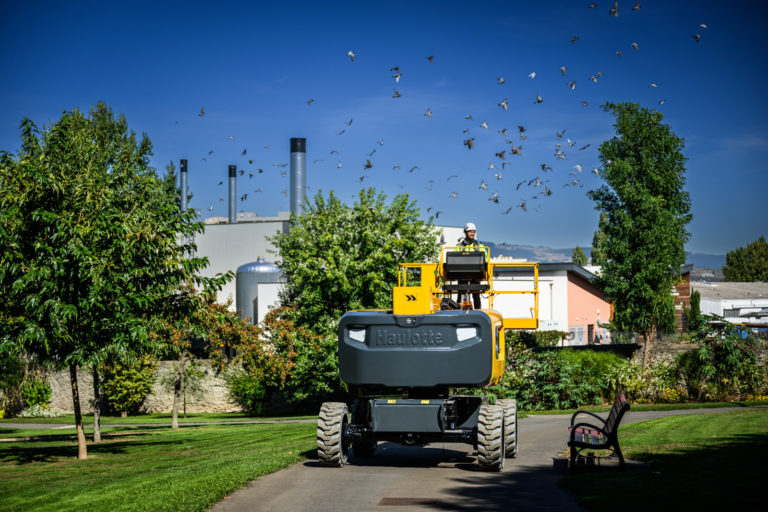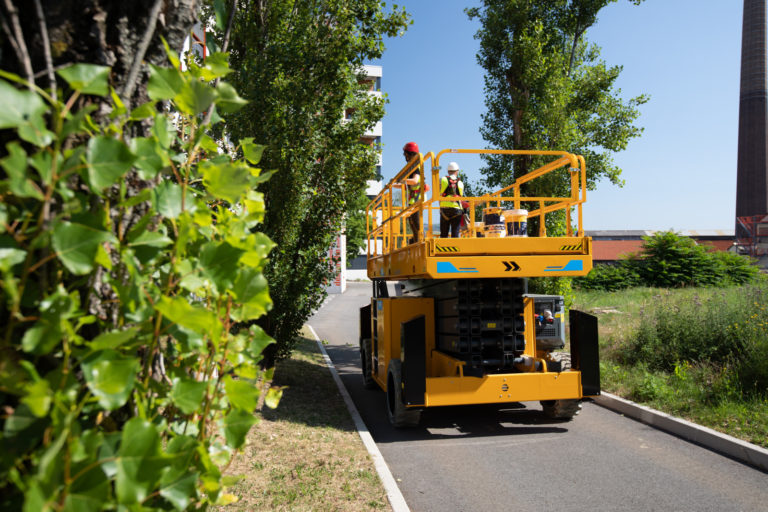Electric vs. Diesel: key differences
Choosing between a diesel-powered and an electric aerial work platform (AWP) depends primarily on the job site environment, operational constraints, and performance requirements. Each technology offers specific advantages, and selecting the right machine is essential to ensure efficiency, safety, and cost-effectiveness on site.
Electric Lifts: These run entirely on electric batteries, making them much quieter than diesel models. They produce no CO2 emissions during use, aligning with various environmental regulations. However, their main drawback is limited battery life, though advancements in battery technology are improving this aspect.
Diesel Lifts: Ideal for outdoor use, diesel lifts usually have longer runtimes than electric lifts. Their downside includes higher emissions and noise levels, which can be disruptive to both operators and nearby individuals.
Advantages of Electric MEWPs
Zero emissions for indoor and low-emission job sites
Electric MEWPs produce no exhaust gases or particulate emissions. This makes them the preferred solution for indoor applications, sensitive urban areas, low-emission zones, and sites where environmental regulations are increasingly strict.
On construction sites located in the EPZ (more info about LEZ at the end of this article), the use of equipment emitting polluting emissions may be prohibited. In this case, electric aerial platforms are the best solution, as they emit no pollutants (VOCs, NOX), and their absence is also a major advantage in densely populated areas.
Significantly reduced noise levels
Electric machines operate much more quietly than diesel units. They are ideal for noise-sensitive environments such as hospitals, public buildings, shopping centers, residential areas, and night-time urban projects. Night work in urban centers imposes strict constraints in terms of noise pollution. In these circumstances, the site machinery authorized to work there must be able to justify a low noise level. Each site defines the admissible noise level, taking into account the surrounding conditions: type and duration of work, repetition of maneuvers, proximity to dwellings, density of the surrounding population, etc.
Indoor–outdoor versatility with the PULSEO range
Haulotte’s PULSEO range offers electric aerial work platforms for both indoor and outdoor use. These platforms combine the advantages of electric and diesel engines, offering great flexibility of use. Operators can easily switch between modes, adapting the machine to the specific constraints of the worksite. Whether for indoor work requiring low noise and zero emissions, or outdoor work requiring greater autonomy, the PULSEO range is the ideal solution!
Green Labeled or Non-Combustion Engine Projects
Construction projects with a « green » label, or those located in areas where combustion engines are prohibited (e.g. certain natural parks or protected areas), call for environmentally-friendly solutions.
Electric aerial platforms, with their zero emissions and silent operation, are the equipment of choice for these sites. They comply with strict environmental standards while delivering optimum performance.
Improved comfort for operator and working environment
No exhaust fumes and low noise contribute to a healthier workspace for operators and other workers on site, an essential factor on high-traffic or sensitive job sites.
Lower operating and maintenance costs
Electric models have fewer moving parts, no combustion engine, and no fluid changes. Combined with the absence of fuel handling, this results in lower maintenance requirements and reduced total cost of ownership over the machine’s lifecycle.



Advantages of Diesel MEWPs
Extended autonomy for long shifts
Where electric machines depend on battery capacity and charging logistics, diesel MEWPs can operate continuously as long as fuel is available. This makes them the optimal choice for extended shifts, remote locations, or job sites without charging infrastructure.
Higher load capacity for heavy-duty applications
Big boom, especially those with higher heights (from 25 meters upwards), are generally equipped with a diesel engine. These models typically support heavier platform capacities, making them ideal for tasks requiring heavy tools and materials or multiple operators with a very high working area.
Which option is best for your project?
| Job site context / criteria | Recommended solution |
|---|---|
| Indoor applications, public buildings, confined spaces, urban environments, noise-sensitive or low-emission zones | Electric MEWPs (including PULSEO): zero emissions, low noise, reduced maintenance |
| Outdoor projects, uneven terrain, heavy-duty work, extended shifts, no charging infrastructure | Diesel MEWPs: power, endurance, stability |
| Mixed environments (indoor + outdoor) with environmental or noise constraints | PULSEO electric models (when suitable) with a range extender option for extended and unlimited duty cycle |
About Low Emission Zones (LEZ).
They are a government tool for improving air quality. Their introduction is a response to the need to protect public health, particularly in large conurbations and cities. An EPZ is a zone where vehicle traffic is restricted, according to specific conditions defined by the local authority. In Europe, there are 320 EPZs*, all with the same objective: to protect the health of residents living in the most densely populated and polluted areas. In Northern Europe, some construction sites in EPZs already restrict access by banning polluting equipment. In view of international climate agreements, we can imagine that regulations will become increasingly stringent over the next few years.